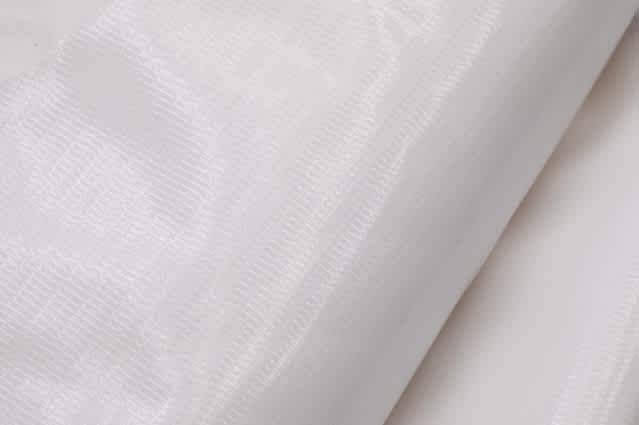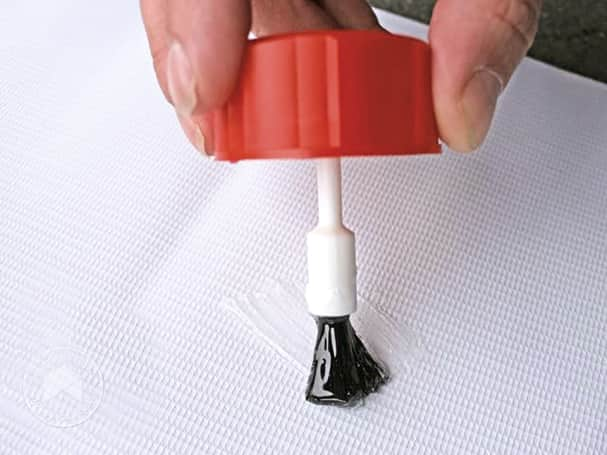
Repair of PE and PVC tent tarpaulins
Marquees and other fabric buildings must be able to withstand environmental influences and mechanical impacts such as wind, sun and precipitation. Damage can occur during prolonged use. Cracks, holes and torn out eyelets should be repaired as quickly as possible so that the tarpaulin does not suffer major damage.
Before you start with the repair, you will need to know what material your tarpaulin sheet is made of. Usually you will find this information on the invoice or in the user manual. Otherwise, we recommend taking the time to contact the company that sold you the tent. Depending on the material, different repair methods are suitable. You will find all the equipment you need in a well stocked tarp repair kit or eyelet kit. At House of Tents you can currently find tarpaulin eyelet repair kits in our online shop. Check back in a couple of months to see if we have other kits in stock!
Here’s what you can expect to find in this article:

How to repair an eyelet (grommet)
Eyelets (you might say grommet – it’s a matter of taste!), are used to
attach a tent cover to the frame. Bungees loop around the poles and
through the eyelet to secure the tent cover, while retaining some give
when the wind blows. The grommet protects the tarp and bungees by
creating a strong and smooth surface where the wind force is absorbed.
To make a new eyelet in your tarp, you will need an eyelet repair kit
including an eyelet setter (mandrel), anvil, and punch alongside brass
eyelet rivets and washers. We recommend using a repair kit with eyelets
that have an inner diameter of 10-12 mm. If the tarpaulin is damaged at
the place where you want to create a new eyelet, deal to this first by
applying a PE or PVC patch.

- 1
First, punch a small hole in the tarp material with an eyelet punch and hammer at the point where you want to form the new eyelet.
- 2
Now place the brass rivet under the punched hole so that the upper, thinner part of the rivet looks out through the hole in the tarpaulin.
- 3
Place the anvil underneath, so that the rivet sits properly in the cavity.
- 4
Place the washer on top of this and press vertically against it with the grommet setter.
- 5
The rivet and washer should be well aligned, with the tarpaulin sitting in between.
- 6
Now hit the hammer onto the setting pin so that the ring and rivet are forced together.
- 7
The thin wall of the rivet, extending upwards from below, will fold over the washer, creating a smooth, rust proof brass protected opening.
Repair of PE tent tarpaulins
In contrast to PVC, PE is difficult to bond with plastic adhesive. Nevertheless, there are possibilities for mending tears and holes in the fabric. Before you get started, the area around the puncture or small rip needs to be cleaned. It is best to place the tarpaulin on a table for easy handling. There are three possibilities for mending a PE sheet: using tape, sewing, or hot air welding.
- 1
Apply duct tape to the tarpaulin
Tape is not a permanent solution, but strong tape temporarily protects against further tearing of the tarpaulin. It is best to reinforce the affected area with adhesive tape on both sides.
- 2
Sewing the tarpaulin of your tent
To prevent the tarpaulin from tearing further, it can be sewn. Use strong thread and a strong needle for this. If you sew a patch over the affected area, this will hold better than directly sewing over the rip. You’re best off applying the repair patch onto the outside of the tent, so that water doesn’t enter the rip and weaken the thread. When the seam is finished, cut off loose threads. The area can be coated with glue or seam sealer for extra durability. If you don’t have any sealant on hand, a piece of repair tape will always help.
- 3
Mending PE tarpaulins with hot air
This form of repair is particularly suitable for large holes. Mending the rip is achieved by welding a piece of PE film onto the PE tent tarpaulin using hot air. The melting temperature of PE is approximately 130-145 degrees Celsius. You will need a device for blowing hot air (hair dryers don’t exceed a maximum temperature of 130 degrees Celsius, so a heat gun is recommended), extra PE tarpaulin sheeting for use as a patch and a pressure roller.
First cut the patches to fit and then place them in the middle of the affected area. Carefully manoeuvre the hot-air gun between the tarpaulin and the PE patches and roll the pressure roller forcefully from above so that the heated, slightly melted materials bond together. Continue this process until the patch is applied without gaps. For best results, patches should be applied on both sides.
Repairing a PVC tarpaulin
The above mentioned repair methods for PE tarpaulins can also be used for PVC tarpaulins. However, it’s important to note that a higher temperature (melting temperature approx. 180 degrees Celsius) is required when patching with hot air. PVC also offers the possibility of applying repair patches using plastic adhesive. This tent repair method is comparable to patching a bicycle tyre, with materials similar in feel to a truck tarp, used for trailers. Make sure that you are working on a large flat surface, where you can spread out the tent fabric.

Bonding – also called solvent welding – should be carried out in an outdoor area or well-ventilated room, because the solvents of the glue are toxic. The adhesive is applied thinly on both the PVC tarpaulin and the PVC patch. After 5 to 10 minutes time, the PVC material will be slightly dissolved – look out for a gelatinous consistency forming on the surface. The glued PVC parts are now placed on top of each other and pressed together. It is best to wear gloves to avoid contact with the adhesive.
Afterwards the join must harden for 24 hours. During solvent welding, the repair patch and PVC tent fabric are not glued together, instead the PVC fabric dissolves bonds together at a molecular level, creating a seamless connection. The process therefore creates a very strong, waterproof join once dry.
Give us a call for advice on tent repairs or spare parts
Are you looking for a kit for gluing, mending or sewing your tent tarp? Do you have any other specific questions about how to repair your tarpaulin, or do you need replacements for a broken pole or connector element? At House of Tents we have 100,000 spare parts including poles, connectors and accessories in stock. If you’re still unsure about how to carry out small repairs, or are unsure if your project is feasible, get in touch!
Call us at +44(0)1183150873 or send an e-mail to service@houseoftents.co.uk.
Alexander
Editor
Hi everyone!
I'm Alexander, one of the editors of the magazine. As a creative mind, my mission is to inspire you and show you the many ways in which our products can be used. I particularly like the practicality of marquees for a garden party. These outdoor shelters offer so many possibilities!
